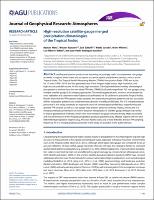| dc.contributor.author | Manz, B. | |
| dc.contributor.author | Buytaert, W. | |
| dc.contributor.author | Zulkafli, Z. | |
| dc.contributor.author | Lavado-Casimiro, W. | |
| dc.contributor.author | Willems, B. | |
| dc.contributor.author | Robles, L.A. | |
| dc.contributor.author | Rodríguez-Sánchez, Juan-Pablo | |
| dc.coverage.spatial | Andes | |
| dc.date.accessioned | 2020-03-24T01:37:19Z | |
| dc.date.available | 2020-03-24T01:37:19Z | |
| dc.date.issued | 2016-02-09 | |
| dc.identifier.citation | "Manz, B., W. Buytaert, Z. Zulkafli, W. Lavado, B. Willems, L. A. Robles, and J.-P. Rodríguez-Sánchez (2016), High-resolution satellite-gauge merged precipitation climatologies of the Tropical Andes, J. Geophys. Res. Atmos., 121, 1190–1207, doi:10.1002/2015JD023788." | en_US |
| dc.identifier.uri | https://hdl.handle.net/20.500.12542/300 | |
| dc.description.abstract | Satellite precipitation products are becoming increasingly useful to complement rain gauge networks in regions where these are too sparse to capture spatial precipitation patterns, such as in the Tropical Andes. The Tropical Rainfall Measuring Mission (TRMM) Precipitation Radar (TPR) was active for 17 years (1998–2014) and has generated one of the longest single-sensor, high-resolution, and high accuracy rainfall records. In this study, high-resolution (5 km) gridded mean monthly climatological precipitation is derived from the raw orbital TPR data (TRMM 2A25) and merged with 723 rain gauges using multiple satellite-gauge (S-G) merging approaches. The resulting precipitation products are evaluated by cross validation and catchment water balances (runoff ratios) for 50 catchments across the Tropical Andes. Results show that the TPR captures major synoptic and seasonal precipitation patterns and also accurately defines orographic gradients but underestimates absolute monthly rainfall rates. The S-G merged products presented in this study constitute an improved source of climatological rainfall data, outperforming the gridded TPR product as well as a rain gauge-only product based on ordinary Kriging. Among the S-G merging methods, performance of inverse distance interpolation of satellite-gauge residuals was similar to that of geostatistical methods, which were more sensitive to gauge network density. High uncertainty and low performance of the merged precipitation products predominantly affected regions with low and intermittent precipitation regimes (e.g., Peruvian Pacific coast) and is likely linked to the low TPR sampling frequency. All S-G merged products presented in this study are available in the public domain. | en_US |
| dc.format | application/pdf | |
| dc.language.iso | eng | en_US |
| dc.publisher | Wiley-Blackwell | en_US |
| dc.relation.ispartof | urn:issn:2156-2202 | |
| dc.rights | info:eu-repo/semantics/openAccess | en_US |
| dc.rights | Atribución-NoComercial-SinDerivadas 3.0 Estados Unidos de América | * |
| dc.rights.uri | http://creativecommons.org/licenses/by-nc-nd/3.0/us/ | * |
| dc.source | Repositorio Institucional - SENAMHI | en_US |
| dc.source | Servicio Nacional de Meteorología e Hidrología del Perú | en_US |
| dc.subject | Precipitation | en_US |
| dc.subject | Calibración | es_PE |
| dc.subject | Clima Tropical | es_PE |
| dc.subject | Método de Evaluación | es_PE |
| dc.subject | Satélite | es_PE |
| dc.subject | Radar | es_PE |
| dc.title | High-resolution satellite-gauge merged precipitation climatologies of the tropical Andes | en_US |
| dc.type | info:eu-repo/semantics/article | en_US |
| dc.identifier.isni | 0000 0001 0746 0446 | |
| dc.description.peerreview | Por pares | |
| dc.identifier.doi | https://doi.org/10.1002/2015JD023788. | |
| dc.identifier.journal | Journal of Geophysical Research | |
| dc.source.volume | 121 | |
| dc.source.initialpage | 1190 | |
| dc.source.endpage | 1207 | |
| dc.subject.ocde | Climatología | es_PE |
| dc.subject.ocde | https://purl.org/pe-repo/ocde/ford#1.05.10 | |
| dc.subject.sinia | precipitacion - Clima y Eventos Naturales | |
| dc.type.sinia | text/publicacion cientifica | |
| dc.identifier.url | https://hdl.handle.net/20.500.12542/300 | |









